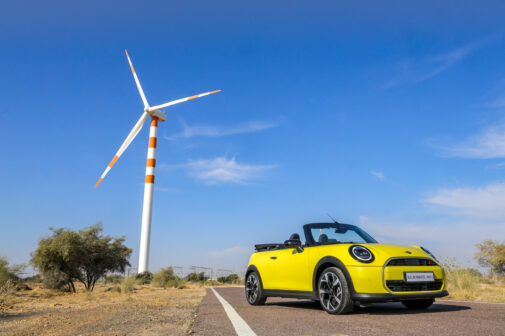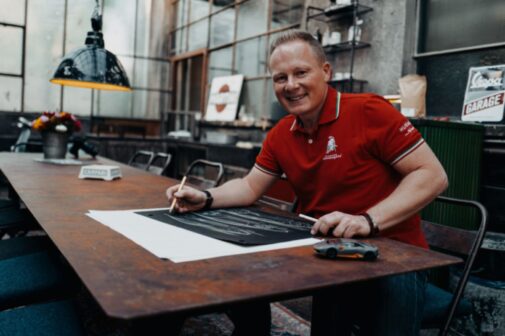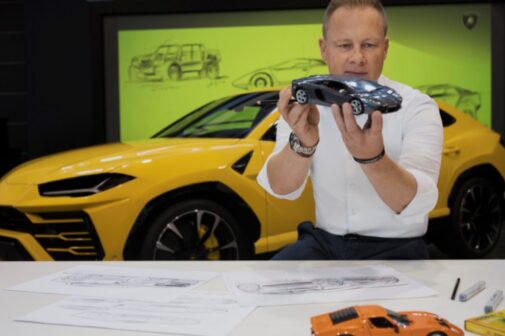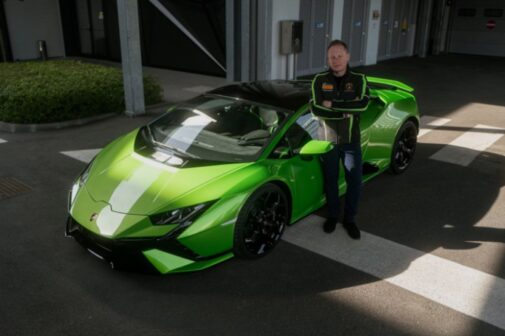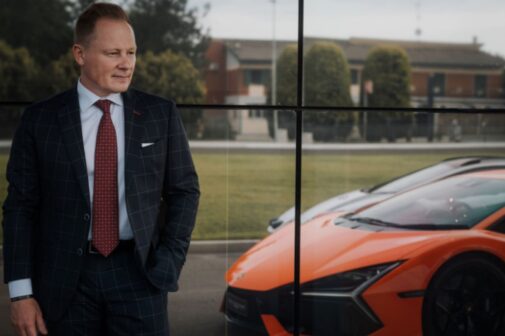Photographs by Lamborghini
Tell us a bit about your journey as an automotive designer. What inspired you to become one?
I have been fascinated with cars from a young age. I was born in East Germany and grew up during the communist period, during which I did not see many cool cars. But without even thinking, I always drew motorcycles, trucks, tanks, cars and so on. Later, I translated my sketches into small wooden models in my father’s garage, even moving his car out of the way to do so. Then, when the wall came down in Germany and the country was reunified, I took the opportunity to study transportation design in Pforzheim, near Stuttgart, and I got my first design position at Porsche.
I started my career as an intern at Porsche in 1997. Then, in February 1999, Harm Lagaay, who hired me, gave me my first permanent job. Later, I worked for Michael Mauer and during this period, I really established my knowledge about proportions, design and how to create models. I created a lot, starting with the Porsche Cayenne, then the 2012 Panamera Sport Turismo concept, and then the Macan. Later, I was appointed director of exterior design, designing the Mission E and some of the concept cars such as the 917 and 904. It was a fantastic period of my life.
In September 2015, Walter de Silva – former head of group design – asked me to lead the Lamborghini Centro Stile. It was amazing. It was very unexpected, and of course, I wanted to do it. It was always a dream for me! Lamborghini is without doubt the dream job for a car designer. It is the epicentre of supercar design – an iconic brand. It was the start of a big personal adventure towards the future, creating the next generation of Lamborghini supercars.
What elements in life do you take inspiration from as a designer, such as art, culture, nature, books, music and so on?
First of all, I walk through life with wide-open eyes. I take inspiration and make my personal decisions about design while travelling around the world, listening or getting a feeling about what’s going on around me, and then anticipating what could be necessary for the future. I like to play some sports and spend time with my family to balance the daily stress.
My greatest source of inspiration, however, remains the motorcycle world. I’m a Moto GP fan and I ride bikes on my own; I like their design solutions about dynamic silhouettes and visual technical details. You can see that a lot in the rear-end designs of our cars, such as the new Temerario, which has exposed rear wheels and a high-mounted exhaust pipe.
I also love music and concerts. The shows that I see and the way they build up the atmosphere are inspiring for me for our presentations and emotional videos. And last but not least, I take inspiration from architecture and nature when travelling. It’s an interesting challenge to imagine our cars looking stunning all around the globe with their different facets, cultures, and surroundings.
Design at Lamborghini is probably the most important element, alongside the engine, because a Lamborghini is primarily a visual experience. How difficult – or easy – is it to be in charge of keeping up that tradition?
Design and performance are the main pillars of a Lamborghini. It doesn’t matter what powertrain we have, we must design a Lamborghini that follows our typical Lamborghini design DNA perfectly. That’s my first measure. Of course, the package and the architecture will be different. We have this gift of a design that looks like a spaceship silhouette, it’s crucial to keep that, but I can play with the silhouette and create so many different characters for cars. For me, it’s important that we first create a beautiful, perfect Lamborghini and that our customers can immediately identify the model, purpose, and mission of a Lamborghini. A Lamborghini’s design is the result of almost sixty years of design history – and it remains as innovative and forward-looking as ever.
In a sense, a firm like Lamborghini is moving against the worldwide design trend, where cars are beginning to look the same, due to a variety of reasons. How do you pull this off while also adhering to safety standards?
The most important statement of our design language is the silhouette. Everyone will have seen a Lamborghini at some point, at least from a distance: a Lamborghini is immediately recognizable as such. It’s that typical architecture, the hexagonal shape of the cabin with the recessed windows and almost horizontal roof. All that makes it stand out so clearly from all the other supercars out there. An important theme is not to always follow the latest trends, like the lines of light, for example. Instead, our focus is on the iconic light signatures, such as the Y or the hexagon.
What’s your favourite Lamborghini, and why?
The Reventón, from 2007. It was the car that made me dream of Lamborghini as soon as I began my career as a professional designer. This model wasn’t the result of my ideas, but it soon became a reality for me, and I must say that the spaceship design of the Revuelto was inspired by an image I had imprinted in my mind, of the Reventón with two pilots and a plane in the background. When I later arrived at Lamborghini, I liked the Countach and other models, but I feel that since its ideation, the Reventón has shaped the thoughts and the language of the future of Lamborghini.
This magazine, Motoring World, has a long connection with Lamborghini. The founding editor, Bijoy Kumar, named his daughter Miura, and every team member through the years has had a Lamborghini nickname. If you were to design a totally wild Lamborghini concept for us, what would it look like and what would you call it?
It would be a remarkable piece of art, visionary and futuristic. Of course, it would follow the Lamborghini design DNA using our stunning single line silhouette, but I would take it further into the future, with an unexpected design theme. Any more I’m not able to say, but for sure, it would be named after an authentic and brave bull!









